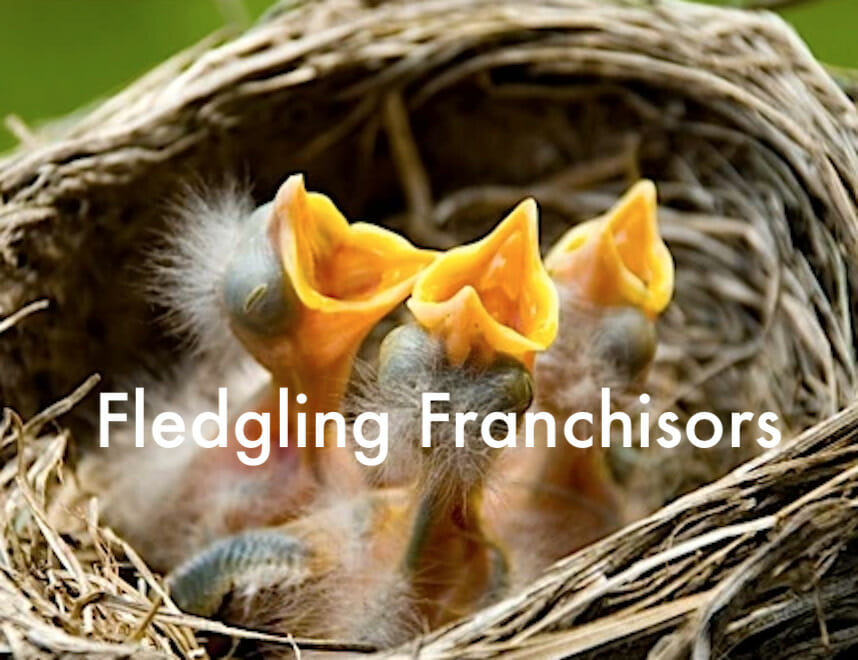Introducing Fledgling Franchises Brands

What Do We Call You?
Last month we held a couple of discovery sessions with a quick service restaurant (QSR) based in California. Legally, they were a franchisor because they had a new franchise disclosure document (FDD) approved by the federal trade commission and the State of California. They also owned several of their own restaurants, but they hadn’t awarded any franchises yet, so they had zero franchisees. Within our industry, this is commonly known as a fledgling franchise brand.
Fledgling Franchisors

Fledgling Franchisors may not have one actual franchisee unit yet.
Current estimates from the International Franchise Association, published in their 2023 Franchising Economic Report, put the total number of franchise brands (franchisors) at approximately 9,000 with more than 800,000 operating franchisee establishments by the end of this year. While the report contains data that categorize franchise brands by geography, industry and economic output, they don’t tell us where these thousands of franchise companies are in their own life cycle. How many franchisors are like our new client – legally a franchisor but without any actual franchisees?
Take Me Back To 2017
While the definition above includes similar words, like “emerging”, that term is also consistently used by franchise professionals and industry media, typically to describe franchise brands with less than 50 or 100 franchise establishments. A study completed in 2017 coined a term “Early Stage” to describe fledgling franchisors with less than 20 units. That’s followed by an inflection point, about five years in, which then refers to franchisors with 21-100 units as “Emerging” before hitting another inflection point at 100 units. While these numbers are obviously dated, we tend to agree with these points, while others might find that many franchisors don’t have any challenges getting beyond 20 or 30 units, but getting to 50 is certainly a challenge for most. For our purposes, we’ll refer to “Fledgling Franchisors” as having 0-25 units and concede that “Emerging Franchisors” likely have 25-99 units.
What Does Artificial Intelligence in 2023 Have to Say?
When we asked Open AI’s ChatGPT about Fledgling Franchisors, it seemed aware of what we were referring to, but also mistakenly used that term and “emerging franchisors” synonymously:
But the remainder of the ChatGPT response was very accurate:
Fledgling franchisors typically have recently started offering franchise opportunities and may have a smaller network of franchisees compared to more established and well-known franchisors. They are still in the process of establishing their brand, refining their business model, and expanding their franchise system.
As a fledgling franchisor, they may face unique challenges and opportunities such as developing effective franchisee recruitment strategies, establishing support systems for franchisees, building brand awareness, and refining their operations to ensure consistency and scalability.
It’s important to note that the term “fledgling franchisor” is not an official designation but rather a descriptive term used to characterize the stage of development of a franchisor in the industry.
https://chat.openai.com/
How many Franchisors in 2023 are Fledgling?
Since the 2023 IFA report didn’t provide life cycle data about franchise brands for 2023, we might make some rough forecasts based upon the 2017 research. At that point in time, approximately 60% of franchise brands had zero to 25 units. If this Fledgling Franchisor ratio were applied to our total franchisor count today, that would equate to about 5,000 franchise brands who fit the “Fledgling Franchisor” category. Another aspect included within the study measure the lifecycle of each franchisor years, but it seems arbitrary to state that a brand that’s been franchising for 10 or 20 years should be considered “mature” even if they only have five actual franchisees within their system. Another question that comes up, since multi-unit franchising has become so predominant over the past decade or so, is “store count” still relevant if those first 20 units might be owned by just two or three franchisees?
Why Is Franchise Lifecycle So Important?
If there are 5,000 franchise brands within the United States that are franchisors legally recognized by the FTC, but 25% of them have zero franchise units, and 36% have fewer than 25 units (the 2017 data) that leaves thousands of franchise brands needing some genuine help to get beyond that first inflection point – moving from Fledgling to Emerging. As you consider new franchise opportunities, and potentially compare franchise brand X to franchise brand Y, establishing the maturity of each brand should be considered. While some might see greater risk (and reward) with a franchise brand just getting started, others might want to be more conservative with their business investment. The bottom line is that by leveraging FranchiseMatch.com to get started with your research and following the coaching process of The Entrepreneur’s Source, you are nearly certain to find an opportunity that has a bright future and suits your short-term goals as well.
